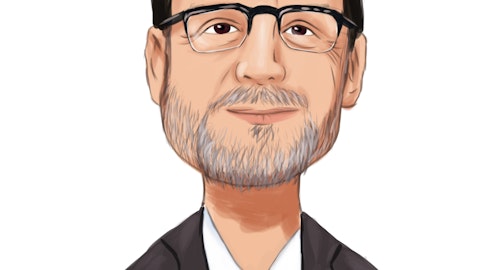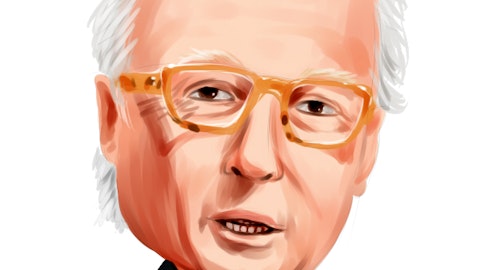Banner Corporation (NASDAQ:BANR) Q4 2022 Earnings Call Transcript January 20, 2023
Operator: Hello, everyone, and welcome to today’s conference, Banner Corporation Fourth Quarter 2022 Conference Call and Webcast. My name is Bruno, and I will be coordinating your call today. I will now hand over to your host, Mark Grescovich, President and CEO of Banner Corporation. Mark, please go ahead.
Mark Grescovich: Thank you, Bruno, and good morning, and Happy New Year, everyone. I would also like to welcome you to the fourth quarter and full year 2022 earnings call for Banner Corporation. As is customary, joining me on the call today is Peter Conner, our Chief Financial Officer; Jill Rice, our Chief Credit Officer; and Rich Arnold, our Head of Investor Relations. Rich, would you please read our forward-looking safe harbor statement?
Rich Arnold: Sure, Mark. Good morning. Our presentation today discusses Banner’s business outlook and will include forward-looking statements. So, statements include descriptions of management’s plans, objectives or goals for future operations, products or services, forecasts of financial or other performance measures and statements about Banner’s general outlook for economic and other conditions. We also may make other forward-looking statements in the question-and-answer period following management’s discussion. These forward-looking statements are subject to a number of risks and uncertainties, and actual results may differ materially from those discussed today. Information on the risk factors that could cause actual results to differ are available from the earnings press release that was released yesterday and a recently filed Form 10-Q for the quarter ended September 30, 2022.
Forward-looking statements are effective only as of the date they are made, and Banner assumes no obligation to update information concerning its expectations. Mark?
Mark Grescovich: Thank you, Rich. Today, we will cover four primary items with you. First, I will provide you high-level comments on Banner’s fourth quarter and full year 2022 performance; second, the actions Banner continues to take to support all of our stakeholders, including our Banner team, our clients, our communities and our shareholders; third, Jill Rice will provide comments on the current status of our loan portfolio; and finally, Peter Conner will provide more detail on our operating performance for the quarter, as well as provide an update on our strategic initiative called Banner Forward. As a reminder, the focus of Banner Forward is to accelerate growth in commercial banking, deepen relationships with retail clients, advance technology strategies and streamline our back office.
Before I get started, I want to again thank all of my 2,000 colleagues in our company that continue implementing our Banner Forward initiatives and who are working extremely hard to assist our clients and communities. Banner has lived our core values, summed up as doing the right thing, for the past 132 years. Our overarching goal continues to be, do the right thing for our clients, our communities, our colleagues, our company and our shareholders, and to provide a consistent and reliable source of commerce and capital through all economic cycles and change events. I am pleased to report again to you that is exactly what we continue to do. I’m very proud of the entire Banner team that are living on our core values. Now, let me turn to an overview of our performance.
As announced, Banner Corporation reported a net profit available to common shareholders of $54.4 million or $1.58 per diluted share for the quarter ended December 31, 2022. This compares to a net profit to common shareholders of $1.44 per share for the fourth quarter of 2021 and $1.43 per share for the third quarter of 2022. For the full year ended December 31, 2022, Banner Corporation reported a net income available to common shareholders of $195.4 million compared to $201 million for the full year 2021. The earnings comparison is impacted by: the provision or recapture of credit losses; excess liquidity, coupled with a rapid change in interest rates; our strategy to maintain a moderate risk profile; a gain on sale of four branches; and the acceleration of deferred loan fee income associated with the SBA loan forgiveness of Paycheck Protection loans.
Peter will discuss these items in more detail shortly. To illustrate the core earnings power of Banner, I would direct your attention to pre-tax pre-provision earnings and excluding the impact of merger and acquisition expenses, COVID expenses, gains and losses on the sale of securities, Banner Forward expenses, changes in fair value of financial instruments and the gain on the sale of branches, full year 2022 earnings were $251.9 million compared to $223.1 million for the full year of 2021. Banner’s fourth quarter 2022 revenue from core operations increased 9% to $175.7 million compared to $161.5 million for the third quarter of 2022, and $143.4 million in the fourth quarter a year ago. For the full year 2022, revenue from core operations increased 6% to $623.1 million when compared to the full year 2021.
We continue to benefit from strong core deposit base and improving net interest margin and good core expense control. Overall, this resulted in a return-on-average assets of 1.34% for the fourth quarter of 2022. Once again, our core performance reflects continued execution on our super community bank strategy; that is, growing new client relationships, adding to our core funding position by growing core deposits and promoting client loyalty and advocacy through our responsive service model. To that point, our core deposits represent 95% of total deposits. Further, we continued our strong organic generation of new relationships, and our loans outside of PPP loans increased 13% over the same period last year. Reflective of the solid performance, coupled with our strong regulatory capital ratios, we announced a core dividend of $0.48 per common share, up 9% from our last dividend.
As noted in the release, Banner published our inaugural Environmental, Social and Governance Highlights Report in December. This report addresses many of the ways in which we are striving to do the right thing to support our clients, our communities and our colleagues. And while it covers many of the items I have mentioned before, including providing SBA payroll protection funds, totaling more than $1.6 billion for approximately 13,000 clients, as well as the $1.5 million commitment to support minority-owned businesses in our footprint, a $1 million equity investment in City First Bank, the largest Black-lead depository financial institution in the United States. It goes much further in outlining the level of commitment Banner has to the many communities in which we serve.
If you haven’t yet, I encourage you to take a few moments to review it. Finally, I’m pleased to say that we continue to receive marketplace recognition and validation of our business model and our value proposition. J.D. Power and Associates ranked Banner the Number One bank in the Northwest for client satisfaction for the sixth time. Banner has been named one of America’s 100 Best Banks by Forbes, and Banner Bank received an outstanding CRA rating in our most recent CRA examination. Let me now turn the call over to Jill to discuss trends in our loan portfolio, and her comments on Banner’s credit quality. Jill?
Jill Rice: Thank you, Mark, and good morning, everyone. As was detailed within our fourth quarter press release, Banner’s credit metrics remain strong. Delinquent loans as of December 31 remained low at 0.32% of total loans, up 10 basis points when compared to the prior quarter and compared to 0.21% as of December 31, 2021. Adversely classified loans represent 1.35% of total loans, down from 1.39% as of the linked quarter and compared to 2.18% as of December 31, 2021. Nonperforming assets remained modest at 0.15% of total assets, but as noted in the press release, increased $7.8 million in the quarter and now total $23.4 million. Nonperforming assets are comprised primarily of nonperforming loans totaling $23 million. Given another quarter of strong loan growth and coupled with the continued negative economic sentiment, we posted a $6 million provision for loan losses and provided an additional $680,000 to the reserve for unfunded commitments.

Photo by Alesia Kazantceva on Unsplash
Net loan losses continued to be modest, and for the full year, Banner reported a net recovery of $1.2 million due to the strong collection work within our Special Assets department. After the provision, our ACL reserve totals $141.5 million or 1.39% of total loans as of December 31, an increase of 1 basis point from the linked quarter and compares to a reserve of 1.45% as of December 31, 2021. The reserve currently provides 615% coverage of our nonperforming loans. Looking at the loan portfolio. Origination volumes continue to be robust in the fourth quarter, with portfolio loan growth of $320 million in the quarter or 13% on an annualized basis. Excluding the growth in the one- to four-family portfolio, the annualized growth rate remained strong at 8%.
C&I activity remained strong in the fourth quarter. For the full year, we reported commercial loan growth of $238 million plus an additional $155 million in the small business scored loans, which on a combined basis, equates to growth of 21% in the commercial lending arena. This growth is in spite of nearly $270 million in payoffs over the course of the past 12 months. The new loan originations continue to be modest in size, much of it to existing clients and is diversified both by industry and geographic location. C&I utilization is flat when compared to last quarter, however, it has increased 3% year-over-year. Commercial real estate balances declined $152 million or 4% year-over-year, a function of the significant CRE payoffs experienced this past year.
Over the past four quarters, commercial real estate payoffs totaled nearly $500 million due to rate and term refinances, property sales and adversely classified relationship exits. As reported in prior quarters, the growth in the multifamily portfolio represents both new term loans as well as the conversion of completed multifamily construction projects, up 26% year-over-year. With the transfer of multifamily held-for-sale loans to the portfolio this quarter, the multifamily portfolio is now approximately 50% affordable housing and 50% market rate, and as noted before, remains granular in exposure and geographically diversified. Construction and development loan balances grew by 3% in the quarter due to draws on commercial and multifamily construction projects.
As anticipated, the volume of one- to four-family residential construction projects has slowed significantly, which is reflected in the reduction in outstanding balances quarter-over-quarter. In total, construction and land development loans reflect an increase of 14% year-over-year, driven primarily by the multifamily construction portfolio. While the volume of residential construction starts has slowed, I am pleased to report that the portfolio continues to perform well and is diversified both in product mix and across our geography. Additionally, our underwriting standards have remained consistent and our land exposure is limited to our strongest sponsors. We expect that we will begin to carry completed homes longer as we move through this next year and anticipate seeing more builder concessions as clients work to keep their finished product moving.
Still, our builders remain well capitalized and prepared to absorb the anticipated slower sales activity. Our total residential construction exposure remains acceptable at 6% of the portfolio. And consistent with prior reporting periods, nearly 40% of that is our custom one- to four-family residential mortgage loan products. When you include multifamily commercial construction and land, the total construction exposure remains at 15% of total loans, consistent with last quarter. And as noted in the earnings release, we again reported solid growth in the consumer mortgage portfolio. Again, a function of moving completed all-in-one custom construction loans on balance sheet. We reported a modest increase quarter-over-quarter in HELOC balances, up 4%, with solid growth of 24% year-over-year due to a very successful home equity campaign recorded in prior quarters.
Lastly, the growth in other consumer loans year-over-year was the result of a small consumer pleasure boat portfolio located within footprint that was completed in the third quarter. I will wrap up my comments as I have the last few quarters noting that the continued overhang of pessimism as it relates to the economic environment we are facing. Still, Banner’s credit culture is designed for success through all business cycles. Our consistent underwriting remains a source of strength, as does our solid reserve for loan losses and robust capital base. Banner’s credit metrics remain strong and our moderate risk profile remains intact, positioning us well to navigate whatever the next phase of this economic cycle brings. With that, I’ll turn the microphone over to Peter for his comments.
Peter?
Peter Conner: Thank you, Jill. And as discussed previously and as announced in our earnings release, we reported net income of $54 million or $1.58 per diluted share for the fourth quarter compared to $49 million or $1.43 per diluted share for the third quarter. The $0.15 increase in earnings per share was due to an increase in net interest income, partially offset by lower noninterest income, higher noninterest expense, and a larger provision for loan losses this quarter. Core revenue, excluding gains and losses on securities, changes in fair value of financial instruments carried at fair value and gains on the sale of sold branches increased $14.2 million from the prior quarter due to an increase in net interest income and noninterest income.
Noninterest expenses, excluding Banner Forward, increased $3.6 million, due primarily to an accrual for a specific litigation matter, increases in occupancy expense and lower capitalized loan origination costs. Turning to the balance sheet. Total loans increased $292 million from the prior quarter-end as a result of increases in held-for-portfolio loans, partially offset by a $27 million decline in held-for-sale loans. Excluding PPP loans and held-for-sale loans, portfolio loans increased $325 million or 13.1% on an annualized basis. One- to four-family real estate loans grew $148 million in the current quarter as a result of directing potential custom construction mortgage loans on the portfolio. We anticipate a slower pace of on-balance sheet mortgage production in the coming quarters.
Ending-core deposits decreased $616 million from the prior quarter-end due to outflows of rate-sensitive balances. The long-term decline in time deposit balances pivoted and increased $2 million from the prior quarter-end for the first time in this rate cycle, as existing clients transferred funds from their core deposit accounts to higher-yielding CDs. We anticipate further declines in core deposit balances, partially offset with growth in time deposits in coming quarters, albeit at a slower pace than we experienced in the fourth quarter, commensurate with the anticipated slowdown in the pace of Fed fund hikes. The loan-to-deposit ratio at the end of the quarter remained at a moderate at 74.5%. Net interest income increased $12.6 million from the prior quarter due to an expansion of the net interest margin, coupled with growth in average loan outstandings and lower balances of lower-yielding overnight interest-bearing cash.
Compared to the prior quarter, loan yields increased 32 basis points, excluding the impact of PPP loan forgiveness, prepayment penalties, interest recoveries and acquired loan accretion. The average loan coupon increased 37 basis points from the prior quarter due to increases in floating and adjustable-rate loans and higher yields on new fixed rate term loans. The average interest-bearing cash and investment balances declined $571 million from the prior quarter, while the average yield on the combined cash and interest balances increased 41 basis points due to higher yields on both the securities portfolio and overnight funds, driven by higher market rates. Total cost of funds increased 5 basis points to 18 basis points due to increases in deposit rates and borrowing costs.
The total cost of deposits increased 3 basis points to 10 basis points, reflecting modest increases in money market rates and CDs. The ratio of core deposits to total deposits remained steady at 95%, the same as last quarter. The net interest margin increased 38 basis points to 4.23% on a tax equivalent basis. The increase was driven by higher yield on loans, securities and overnight cash, coupled with a larger mix of loans and a lower mix of overnight cash within the earning asset base. In the coming quarters, we anticipate a slowdown in the pace of margin expansion as rate-sensitive deposits move off the balance sheet, the pace of loan yield increase slows, overnight interest-bearing cash levels decline and deposit rates increase. Going forward, we anticipate loan growth and deposit outflows will be funded primarily with security sales and secondarily with borrowings.
Total noninterest income declined $2.5 million from the prior quarter. The current quarter was impacted by a $3.7 million loss on the sale of securities. Core noninterest income, excluding the gains on sales of the securities, gain on the sale of branches and changes in investments carried at fair value, increased $1.6 million. Total deposit fees decreased $628,000 while mortgage banking income increased $2.2 million due to an increase in the fair value of multifamily loans held for sale, partially offset by a decline in residential mortgage gain on sale income. Total residential mortgage production, including both loans held for investment and those held for sale, declined 49% from the prior quarter, reflecting the continued headwinds of higher rates and a slowdown in home sales.
Within residential mortgage production, the percentage of refinance volume continued to decline as a function of rising rates, dropping to 10% of total production, down from 12% in the prior quarter. Multifamily loan production remained even with the prior quarter and the fair value of the held-for-sale portfolio improved as a function of higher yields on recently originated loans and a decline in market rates. Miscellaneous fee income decreased due to gains on nonperforming loans taken in the prior quarter. Total noninterest expense increased $4 million from the prior quarter, due to an accrual for an anticipated settlement of a previously disclosed litigation matter, lower deduction for capitalized loan origination costs and an increase in Banner Forward-related occupancy exit costs.
Excluding the litigation settlement accrual and Banner Forward, noninterest expense was flat to the prior quarter. Capitalized loan origination costs decreased due to lower construction one- to four-residential mortgage and HELOC loan production compared to the prior quarter. Compensation expense declined by $1.3 million, due to declines in mortgage loan commission and medical claims expense. Occupancy expense — occupancy and equipment costs increased $1.5 million due to Banner Forward-related facility exit costs and weather-related building maintenance expense. Professional and legal expense increased $3.7 million due to the aforementioned anticipated settlement of an outstanding litigation matter. Majority of the Banner Forward program initiatives were in place as of the current quarter.
We anticipate the remaining run rate in Banner Forward-related performance improvements to occur over the course of 2023 as additional administrative building space is consolidated along with anticipated increases in selected deposit product service charges and continued acquisition of small business and middle market relationships. In closing, the company continues to benefit from rising rates, along with the improved operating leverage put in place by Banner Forward as evidenced by the significant improvement in the company’s core ROA and efficiency ratio. This concludes my prepared remarks. Mark?
Mark Grescovich: Thank you, Peter and Jill, for your comments. That concludes our prepared remarks. And Bruno, we will now open the call and welcome your questions.
See also 10 Value Stocks with Big Buybacks and 25 Wealthiest Countries in the World by GDP per capita.
Q&A Session
Follow Banner Corp (NASDAQ:BANR)
Follow Banner Corp (NASDAQ:BANR)
Operator: Perfect. Thank you, Mark. Our first question is from Jeff Rulis from D.A. Davidson. Jeff, please go ahead. Your line is now open.
Jeff Rulis: Thanks. Good morning.
Mark Grescovich: Good morning, Jeff.
Jeff Rulis: Just a question on the non-accruals, it looks like the increases in the C&I and 1 to 4 family, could you offer any color as to — is it timing or anything that you’re seeing there? And just thoughts on overall, Jill, I appreciate the kind of the statistics of delinquency and other, but specifically those credits that were added and then just a general sense type of commentary.
Jill Rice: Yes, good morning, Jeff. So as to the change in the non-performing, you hit the categories, there isn’t any one specific driver on the 1 to 4 family. Some of it is timing. December is month where people tend to put their cash into things other than their mortgage at times. But beyond that, we had a small modest SBA guaranteed loan put on non-accrual, while we work through the credit resolution process and then various small business loans, nothing that is tending to point to any one issue or any one industry or things like that at this point, Jeff?
Jeff Rulis: Okay. And maybe, Peter, on the expenses, I guess, core expenses in the, call it, the mid-90s. You mentioned there can be some probably some Banner Forward exit costs potentially if there’s more consolidation. But just kind of getting a sense for kind of growth rate off of maybe that 95-ish base for ’23. And if you can touch on your expectation on additional Banner Forward expenses, that would be helpful.
Peter Conner: Sure, Jeff. Yes, the — so in terms of our guidance for ’23, we continue to guide in the low to mid-90s in terms of core expense. For 2023, we have some ins and outs going into ’23. We’ll have some reductions in occupancy expense as those facilities are consolidated over the course of ’23. We don’t anticipate any material restructuring or exit costs. There might be a few modest amounts there, but nothing material for ’23. And then we do anticipate the compensation line item to continue to run, albeit for first quarter where we have some payroll tax increases to run at or perhaps even a little bit lower than what we had in the fourth quarter because of some elevated bonus, incentive accruals that we are running in Q4.
So, my guidance is we’ll see something basically similar to that low to mid-90s throughout the course of 2023 with somewhat higher first quarter compensation costs. But overall, we don’t see a large increase in the run rate of the expense base going into ’23.
Jeff Rulis: Okay, I will step back. Thank you.
Mark Grescovich: Thanks, Jeff.
Operator: Perfect. Thank you, Jeff. Our next question is from David Feaster from Raymond James. David, your line is now open. Please go ahead.
David Feaster: Hey, good morning, everybody.
Mark Grescovich: Good morning, David.
David Feaster: I just wanted — I wanted to touch base on kind of your thoughts on credit in some regard, you tend to have a very conservative approach and good insights. But curious as maybe as you look at your portfolio and you stress some of the floating rate borrowers that have seen their borrowing costs increased materially over the past 12-months. Have you seen any material changes in debt service coverage ratios? And as you look at the prospects for another 50 basis points of hikes or whatever, how do cash flows and collateral values change? And as some of these loans come up for renewal, just how are you thinking about it? And ultimately, how do you think about the impacts on credit quality? Do we see more restructurings? Or just curious how you think about it.





